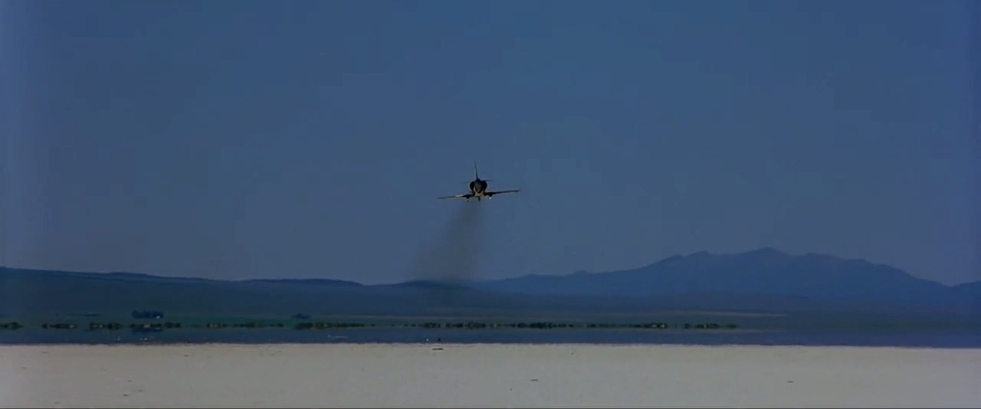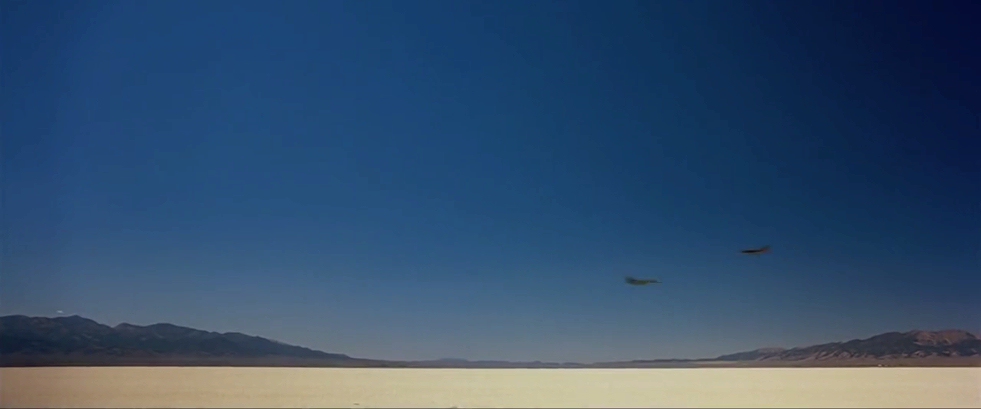so long, pete mitchell
[EDIT: If anyone is coming to this blog from the Believer article, welcome. To find the daily pieces on Groundhog Day you've got to look at August 2013 to August 2014. And, I will be watching Groundhog Day and writing an entry related to it later today--today being February 2. The piece below was posted late last night for February 1st. For the month of January, I watched 5 action movies from the 1980s. Enjoy.]
Let us get the most important item out of the way first off on this last day with Top Gun:
There’s a question on Quora—In Top Gun, why was Jester allowed to fly below the “hard deck,” but Maverick and Goose were reprimanded for it? But, I’ve got a better question—if the “hard deck” was 10,000 feet and Maverick gets in trouble for flying below said altitude, what were both jets doing flying so low well before the moment in question? I mean, look at this:





Does that look like they are above 10,000 feet? (It’s so low, it reminds me of the opening titles sequence for Airwolf.
But, of course, the point is not accuracy but to let us know that Maverick is reckless and is willing to do the wrong thing to win. Without that, we don’t get a character arc.
Next item of business for this last day with Top Gun: Ehud Yonay deserves a mention. Who is Ehud Yonay? He wrote the article that inspired Top Gun in the first place. I haven’t managed to find a copy of the original article but it was called “Top Guns” and it ran in the May 1983 issue of California magazine. Yonay died in 2012 at age 71.
Next up, the real-life Maverick:
Bryan Hackett (2013) at Parantap Strategy speculates that screenwriters Jack Epps, Jr. and Jim Cash built the details of their script around one real-life pilot in particular—Colonel John Boyd. As Hackett describes it, at TOPGUN Boyd had a “standing challenge that he could beat any pilot in a simulated air combat fight in less than 40 seconds.” Reminds me of Hop 1 in the movie. Hollywood and Wolfman lose to Jester in less time than that. You might remember this bit with Wolfman in the locker room:
We got our butts kicked. 30 seconds. We went like this, he went like that. I said to Hollywood, “where did he go?” Hollywood said, “Where’d who go?”
Boyd, like Maverick, lost his father at a young age and had clashes with his superiors. But, most interestingly, he was known for a maneuver called “flat plating the bird.” This is basically what we see Maverick do on Hop 1 and on the final mission in the film. In a 2002 book, Boyd, Robert Coram describes it:
He would seize the stick with both hands, jerk it full aft, and hold it there. This maneuver... turned the bottom of the aircraft, the wings, and the bottom of the tail surfaces into one enormous air speed brake and slowed the Hun from 400 knots to 150 knots in seconds. (Quoted in Hackett, 2013)
The followup is more complicated than what we see in the film, though. Coram continues:
Then Boyd, still holding the stick full aft and not moving it a quarter inch in either direction, would stomp hard on the rudder and corkscrew the aircraft violently around in a tight roll. (ibid)
Epps and Cash visited TOPGUN and spent time with some pilots in putting the script together, but in a letter to Hackett, Epps says,
I do not know of Colonel Boyd nor of his exploits. Maverick was a character created by me and my partner, Jim Cash. Maverick was part Joe Namath and part both Jim and me. We were both hard driving individuals who were motivated to be either that starting High School quarterback in Jim’s case, or for me it was being the starting goaltender at Michigan State University. We were influenced by the many type A first born personalities we meet [sic] at the Top Gun school. But in the end, Maverick was a total product of our imaginations. (posted in Hackett)
Maverick, really, is a fairly generic character, and that putting-on-the-brakes routine is an easy visual way to let the audience know he’ll do crazy shit to win. We have already seen him abandon his wingman and fly his inverted plane so close to an enemy MiG that we’ve got to wonder if there is room for either plane’s tail between them. But, a) we’ve got to have it made even more concrete, get Maverick yelled at again (because, that puts him in line with the likes of Dirty Harry Callahan, an antihero we all love because he doesn’t take shit from authority figures—rugged individualism at its cinematic best), and b) it sets up the same move being used in the final dogfight. Chekhov’s braking maneuver, if you will.
As Maverick and Charlie kiss in silhouette on my TV, I got to wonder now if there’s anything I’ve missed this past month, spending time with 1980s action movies. Like I argued back in October that slasher films were a response to feminism (in part, possibly a very big part), these action movies seem to be a response to the loss in Vietnam
(again, in part, but possibly a very big part... 80s extravagance meant big budget action movies were more possible than they would have been before, too. Though there is an obviously different political angle to Rambo: First Blood Part II relative to First Blood, there is also an obviously larger budget. One could make the argument that the larger explosions drove the political change—it’s hard to imagine an antiwar hero firing those explosive arrows—rather than the opposite, that a political change to the right meant more destruction was appropriate. But, really, that’s the fun in looking closely at film. Different interpretations can be argued regarding just about anything.Is Rambo a feminist film? Sure, why not? While she may get shot, Co Bao is just as sneaky (sneakier in the original script) as Rambo, just as deadly, and possibly more clever (with that prostitute ruse). Her death drives us into the third act (though I still say there is not a distinct enough break between the second and third acts), her death drives the movie. But she does not die because she is a woman. I mean, in context of the film itself, her death is a surprise. See enough movies and you can identify that moment as the woman being a prop to fuel the man’s rage, but in that film’s specific context, that message is not present.
Is Commando a Marxist film? Sure, why not? Arius’ far too large (considering, it’s supposed to be off the coast of California) military camp could represent the factory system that eats up the individual. Those soldiers are so anonymous that some of them have the same faces (the same stuntmen being used for multiple deaths, if we’re talking behind-the-scenes reality, but isn’t there a Marxist angle in that, too? Or a union conversation to be had, at least?) and some are just mannequins (seriously, when those buildings explode, watch all those mannequins shake; it’s wonderfully amusing). Arius is (re)building his power on the backs of expendable, interchangeable soldiers. There’s definitely something there.
Can you apply Queer Theory to Lethal Weapon? Freudian psychology to Die Hard? Does Top Gun deal in myth criticism? That is, does Top Gun comment on or breakdown the foundations of our civilization? Are these aviators stand-ins for gods? Men of great prowess on the big screen for us to worship and emulate.
Any film can be broken down in any manner. Some better than others, of course. But that’s no reason not to try.)
and any movie can really be seen as a response to its time, a comment on society, on culture, on gender, on the play of ideas going around.
That is why, tomorrow, I just might have to figure out how declining American hegemony led us to Groundhog Day. Should be fun.
Congratulations on the article, that's awesome!
ReplyDeletefull body massage in south delhi
ReplyDeletebody to body massage near me
body massage deals in delhi
delhi massage parlour body to body
full body massage center in delhi
full body to body nuru massage and spa near me delhi with extra service
Nuru massage center in Delhi Green park
best spa body to body south Delhi
body massage center in delhi
massage in delhi body to body
beauty services at home
ReplyDeletebody massage service in delhi
full massage in delhi
Full body to body Nuru massage in Delhi
body to body massage center in Delhi Green park
best spa body to body south Delhi
massage body to body in delhi
body massage in connaught place
massage parlour new delhi
body massage in new delhi
best body massage spa in delhi
ReplyDeletemassage full body delhi
Happy Ending massage center in Delhi Green park
best spa body to body south Delhi
ladies massage center in delhi
oil body massage in delhi
full body massage in new delhi
best massage centre in delhi
full body massage parlour in delhi with price
massage deals in delhi
male massage therapist delhi
ReplyDeletebody to body massage center in Delhi Green park
best spa body to body south Delhi
new delhi massage centre
massage parlour in delhi for male
b to b massage in south delhi
man massage centre in delhi
massage spa in south delhi
massage center in south delhi
massage parlour in delhi body to body
body massage center in Delhi Green park
ReplyDeletebest spa body to body south Delhi
full body oil massage in delhi
Body to body Erotic Nuru massage in Delhi by female to male
body massage in malviya nagar delhi
best body massage center in delhi
massage centre in delhi ncr
spa massage parlour in delhi
full body massage in paharganj delhi
spa parlour in delhi
best spa body to body south Delhi
ReplyDeletenew delhi massage service
full body massage at home in delhi
ayurvedic massage in delhi
full body massage service in delhi
body massage for mens in delhi
erottic massage
good massage in delhi
couple spa deals in delhi
bangkok massage in delhi
The benefits of best body massage near Vancouver include increased blood circulation, mental and physical relaxation, decreased stress and muscle tension and improved range of motion.
ReplyDelete